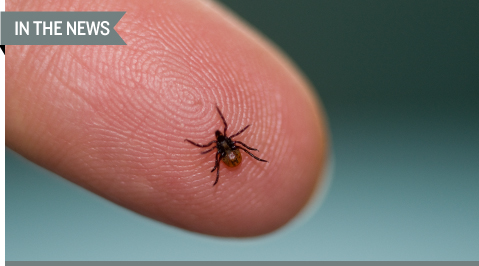
Lauree Feldman / Photolibrary / Getty Images
Shortcomings in diagnostic tests to measure and pinpoint tickborne diseases need attention at a time when incidence of Borrelia mayonii or Lyme disease and related illnesses is on the rise in the United States, experts caution. Solutions call for a federal investment in direct laboratory tests for infection such as nucleic-acid-based tests or antigen-based tests and investigations into emerging diagnostic technologies.
“The number of U.S. counties now considered to be of high incidence for Lyme disease has increased by more than 300% in the Northeastern states and by approximately 250% in the North Central states,” a federal task force noted in its first report. New discoveries in tickborne pathogens categorize these diseases as a “serious, potentially deadly, and rapidly growing threat to public health,” according to the Tick-Borne Disease Working Group, a 14-member federal advisory committee established by Congress that represents members of the federal government, research, healthcare, and patient communities.
“This report is an important first step in bringing together all relevant stakeholders to develop solutions to this critical—and growing—public health problem in the U.S. today,” said John N. Aucott, MD, chair of the Tick-Borne Disease Working Group and director of the Johns Hopkins Rheumatology Lyme Disease Research Center in a statement. “The bottom line is: We need to find better ways to care for our patients and these recommendations will help us do that.”
Other reports point to similar trends. Cases of tickborne diseases reported to health departments in the United States set a record in 2017, rising from 48,610 to 59,349 cases over a year’s period, according to the latest data from the Centers for Disease Control and Prevention (CDC). Lyme disease, the most common tickborne illness in this country, accounted for a majority of the cases, which also included anaplasmosis/ehrlichiosis, spotted fever rickettsiosis, babesiosis, tularemia, and Powassan virus disease. Earlier this year, CDC reported that tickborne bacterial and protozoan diseases had doubled from approximately 22,000 in 2004 to 48,000 in 2016, with Lyme disease accounting for more than 80% of all tickborne reports.
Lyme disease affects more than 300,000 people annually. According to one new study, climate change may further exacerbate these figures. The researchers estimated that rising temperatures will increase cases by 21% midcentury (2036–2065), resulting in 8.6 more cases per 100,000 individuals per year.
Yet, very few cases of tickborne diseases are reported to CDC or state and local health departments. The Tick-Borne Disease Working Group received stories from advocates and patients alike about debilitating symptoms from tickborne illness. Treatments often take place over a long period, which rack up medical bills that insurers won’t always cover. “Studies indicate that Lyme disease costs approximately $1.3 billion each year in direct medical costs alone in the United States,” according to the report’s authors.
The report underscores accuracy problems with current diagnostic tests. Clinicians often find it difficult to interpret results and make an accurate diagnosis—a key factor in crucial early treatment of tickborne diseases. Different labs can yield different test results, depending on which test kits they use. Serological assays aren’t always reliable, producing negative results sometimes days or weeks after the initial infection. “Serology may not detect all cases of tickborne disease, particularly in persons who do not produce detectable levels of antibodies in response to infection, and in patients who were treated with antibiotics at the beginning of the infection,” according to the task force authors.
Evaluating new diagnostic tests and platforms for Lyme disease and other tickborne diseases would help reduce societal burden and related costs of these diseases and reduce the likelihood of false-positive results. “A strong federal response and immediate investment would help enable rapid improvements,” the task force recommended.
Researchers have made inroads on a number of promising technologies. Improved serological tests have the ability to target components from Borrelia or simultaneously detect all tickborne infections. In addition, metagenomic sequencing of DNA/RNA and proteomics show promise in detecting tickborne pathogens in clinical samples. Other emerging technologies such as microfluidics, affinity capture technology, cytokine release assays, and nanopore sequencing could be repurposed for tickborne pathogen identification, the report suggests.
Right now, a need exists for tissue-based diagnostics with improved polymerase chain reaction and immunohistochemical staining of pathology specimens. Such technologies are only available at a handful of reference labs, Aucott told CLN Stat. Urgent care centers in the meantime could leverage point-of-care tests to streamline diagnosis and allow for earlier therapy. “This could be a direct test or a serologic test,” he said.